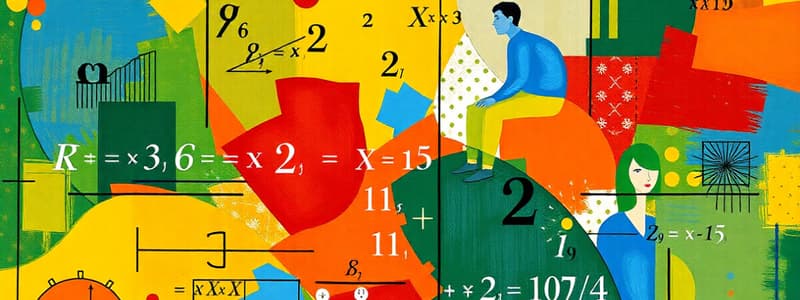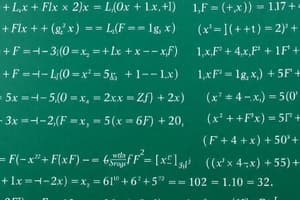Podcast
Questions and Answers
What is the purpose of variables in algebra?
What is the purpose of variables in algebra?
- To represent fixed values
- To represent unknown quantities (correct)
- To perform mathematical operations directly
- To manipulate expressions without changing their values
Which operation should be performed first according to the Order of Operations?
Which operation should be performed first according to the Order of Operations?
- Multiplication
- Parentheses (correct)
- Subtraction
- Addition
What type of equation graphs as a straight line?
What type of equation graphs as a straight line?
- Polynomial equation
- Linear equation (correct)
- Rational equation
- Quadratic equation
Which method is NOT used to solve equations?
Which method is NOT used to solve equations?
Which of the following correctly describes inequalities?
Which of the following correctly describes inequalities?
In the expression $3x + 5$, what are the components?
In the expression $3x + 5$, what are the components?
What will happen to the inequality sign when multiplying or dividing by a negative number?
What will happen to the inequality sign when multiplying or dividing by a negative number?
What defines a quadratic equation?
What defines a quadratic equation?
What is the slope-intercept form of a linear equation?
What is the slope-intercept form of a linear equation?
Which method is NOT typically used for solving systems of equations?
Which method is NOT typically used for solving systems of equations?
What does it mean if a system of equations has no solutions?
What does it mean if a system of equations has no solutions?
Which of the following is true about functions?
Which of the following is true about functions?
What is a common technique used for factoring polynomials?
What is a common technique used for factoring polynomials?
Which of the following methods can be applied to solve quadratic equations?
Which of the following methods can be applied to solve quadratic equations?
What is the result of applying the product rule of exponents, using $a^3$ and $a^4$?
What is the result of applying the product rule of exponents, using $a^3$ and $a^4$?
In which application is algebra NOT commonly used?
In which application is algebra NOT commonly used?
Flashcards
Algebra
Algebra
A branch of math using symbols to represent numbers and quantities in equations and formulas.
Variable
Variable
A letter or symbol representing an unknown quantity in an equation or expression.
Order of Operations
Order of Operations
A rule that dictates the sequence for evaluating mathematical expressions (PEMDAS/BODMAS).
Solving an equation
Solving an equation
Signup and view all the flashcards
Linear equation
Linear equation
Signup and view all the flashcards
Inequality
Inequality
Signup and view all the flashcards
Solving inequalities
Solving inequalities
Signup and view all the flashcards
Combining like terms
Combining like terms
Signup and view all the flashcards
Standard Form of a Linear Equation
Standard Form of a Linear Equation
Signup and view all the flashcards
Slope-Intercept Form
Slope-Intercept Form
Signup and view all the flashcards
Point-Slope Form
Point-Slope Form
Signup and view all the flashcards
System of Equations Solutions
System of Equations Solutions
Signup and view all the flashcards
Quadratic Formula
Quadratic Formula
Signup and view all the flashcards
Factoring
Factoring
Signup and view all the flashcards
Function
Function
Signup and view all the flashcards
Quadratic Equation Solutions
Quadratic Equation Solutions
Signup and view all the flashcards
Study Notes
Basic Algebra Concepts
- Algebra is a branch of mathematics that uses symbols, typically letters, to represent numbers and quantities. These symbols allow for the manipulation and solution of equations and formulas.
- Variables are letters or symbols that represent unknown quantities.
- Constants are symbols that represent fixed values.
- Expressions are combinations of variables, constants, and mathematical operations.
- Equations are mathematical statements that show the equality of two expressions.
- Inequalities are mathematical statements that show the relationship between two expressions (e.g., greater than, less than).
- Properties of equality and inequality are fundamental to manipulating and solving equations and inequalities.
Fundamental Operations
- Order of Operations (PEMDAS/BODMAS): This rule dictates the sequence in which mathematical operations should be performed to evaluate expressions. Parentheses/Brackets, Exponents/Orders, Multiplication and Division (left to right), Addition and Subtraction (left to right). Understanding this is crucial for achieving accurate solutions.
- Addition, subtraction, multiplication, and division of algebraic terms. Similar terms can be added or subtracted, while multiplication distributes over addition and subtraction.
Solving Equations
- Solving an equation involves isolating the unknown variable.
- Methods used to solve equations include:
- Adding or subtracting the same value from both sides of the equation.
- Multiplying or dividing both sides of the equation by the same value (excluding zero).
- Using the distributive property.
- Combining like terms on each side of the equation.
- The solution to an equation is the value of the variable that makes the equation true.
Types of Equations
- Linear equations: Equations that involve variables raised to the power of 1. Their graphs form straight lines.
- Quadratic equations: Equations that involve variables raised to the power of 2. Their graphs form parabolas.
- Polynomial equations: Equations with more than one variable, any of which could be raised to a power greater than 1.
- Rational equations: Equations involving fractions containing variables in the denominator.
Inequalities
- Solving inequalities is similar to solving equations, but the direction of the inequality sign might change depending on the operation performed.
- Multiplication or division by a negative number reverses the inequality sign.
Linear Equations (Further Detail)
- The standard form of a linear equation is typically presented as Ax + By = C.
- Slope-intercept form (y = mx + b) allows for determining the slope (m) and y-intercept (b) of a line. This form is readily usable for graphing and analysis.
- Point-slope form (y - y1 = m(x - x1)) uses a point (x1, y1) and the slope (m) to find the equation of a line.
Systems of Equations
- Systems of linear equations can be solved graphically or algebraically (e.g., substitution or elimination methods).
- Systems of equations have single solutions, no solutions (parallel lines), or infinitely many solutions (same line).
Functions
- Functions describe relationships between input (independent variable) and output (dependent variable).
- Functions can be represented by equations, tables, or graphs.
- Input values must map to only one output value.
Exponents and Polynomials
- Understanding rules related to exponents (e.g., product rule, quotient rule) is essential for working with polynomials.
- Operations with Polynomials include addition, subtraction, multiplication, and division.
Factoring
- Factoring is a technique used to rewrite a polynomial expression as a product of factors.
- Common factoring involves identifying and removing a common factor.
- Other advanced factoring techniques exist for more complicated polynomials (e.g., grouping, difference of squares).
Quadratic Equations (Further Detail)
- Solving quadratic equations can utilize the quadratic formula: x = (-b ± √(b² - 4ac)) / 2a.
- Alternatively, factoring, completing the square, or graphing techniques can be applied.
- Quadratics have at most two solutions.
Applications of Algebra
- Algebra is widely used in various real-world applications:
- Physics (formulating equations of motion)
- Engineering (designing structures and systems)
- Finance (calculating investments and interest)
- Computer Science (programming and algorithm development)
- Various sciences (modelling and analysis)
Studying That Suits You
Use AI to generate personalized quizzes and flashcards to suit your learning preferences.




